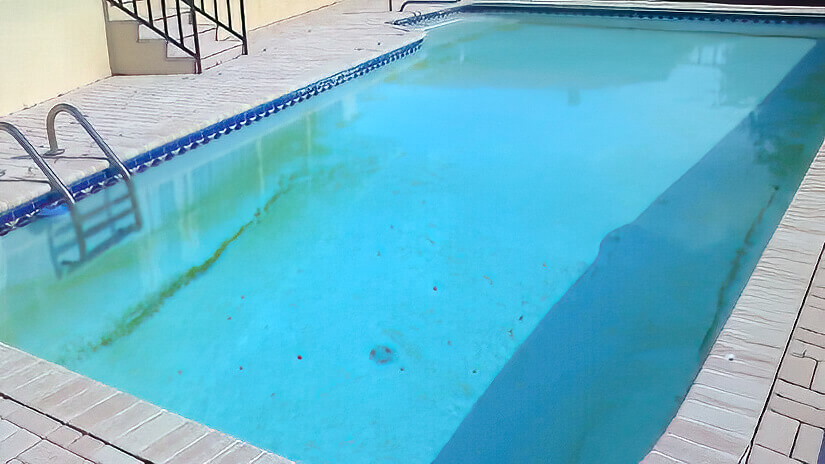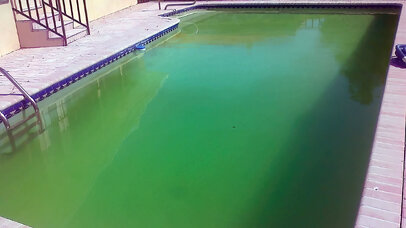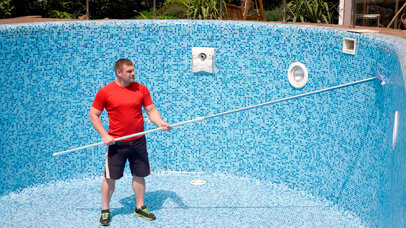Uh-oh, is your pool green? Everybody loves having a swimming pool to dip in when the mood hits. But maintaining that crystal clear water isn’t always easy.
Regularly inspect your pool to prevent green water or the onset of algae growth. If you have been away from the pool for a long time, you might be greeted upon returning with an algae-filled water body.

Green pool water isn’t a beautiful sight, so we shall walk you through how to resolve a green pool. At the same time, we’ll also include some tips for maintaining the clear blue waters of pools in the future.
So, without further delay, let’s dive into how to clean a green pool.
Steps to Clean Green Pool Water
1. Draining the Pool

Although this is the most extreme step, few other options are left if the pool turns dark green and borders blackish. In such cases, draining the pool completely and treating the surface with an acid wash is always more effective.
If one can see six to eight inches below the water’s surface, adding appropriate chemicals for effective pool cleaning is advisable. The pool owner must decide whether to continue chemical treatment or complete draining if such visibility is obscured.
2. Lowering the pH Level

Before adjusting the pool’s pH level, it’s crucial to test a water sample to understand its current state. Without getting into the specifics, we should inform you that there are numerous water chemistry test kits to help in this process.
The pool won’t turn green if the free chlorine levels are sufficient. So, one might skip that step. However, it is optimum to have it below 7.2 for this process regarding the pH level. Otherwise, the pool will likely get cloudier over the next few steps.
Once users know the pH levels, sodium bisulphate can help reduce them, and the method is straightforward. You need to follow manufacturing instructions while adding the product to the pool. Tests must be conducted again in a few hours to observe results.
3. Shocking the Pool

After adjusting the pH levels, the next essential step is a chlorine shock treatment to address the pool’s severe chlorine deficiency and stabilize the cyanuric acid levels. Adding granular chlorine or super shock chlorine helps kill off the algae and bacteria almost immediately.
While most products provide specific instructions for how much chlorine to use, the safer measure would be 30 ppm or parts per million. After the application, users are advised to check the right balance before using the testing kit.
4. Pumping and Filtering

The pool’s almost ready to return to its sparkling self. But it would be best to pump and filtrate the pool water to regain balance. The filtering process depends on the type of filter used, such as a cartridge filter, sand filter, or DE filter.
Some basic steps include shutting the pump, rolling out the backwash hose, and checking for closed valves in the waste line. Then, the multiport valve handle must be turned to backwash, or the push-pull valve must be slid in.
Following this, the pump has to be turned on to flow through the backwash hose or pipe. It usually takes two to three minutes for the water to become apparent. Then, the valve needs to be turned to filter again. Immediately, the better flow rate and the lower pressure of the filter tank become evident.
5. Flocking the Pool

Even after doing all this, the pool might remain a little cloudy. This is primarily due to the residual microscopic particles, which resist pool chemicals and are small enough to escape the filtration process. The best way to tackle this is by using flocculants.
The organic chemicals help to clump the debris together to be vacuumed from the pool’s floor. It is bound to leave the pool water crystal clear.
6. Killing Algae

Algae can be very persistent. Despite many feelings that this step isn’t necessary, avoiding repeating the same process in a week is crucial. Since algae have a fast growth rate and can take over the pool, killing it is mandatory.
Using an effective algaecide makes it drop to the bottom of the floor. After killing off the remaining spores, continued treatment is recommended to prevent the algae from returning.
Why Does the Pool Turn Green?
Now that you know how to treat a green pool, you should focus on why it might turn green in the first place. After all, understanding the causes might help prevent them.
An overgrowth of algae is the underlying common cause, but different factors could lead to overgrowth.
1. Improper pH Levels
If the pH level is too low, it could cause eye irritation and erosion of pool materials. On the other hand, high pH levels won’t kill the algae and bacteria. Ultimately, pH levels that are off-balance cause water discolouration.
2. Filter Clogging
Maintaining a sparkling pool becomes daunting if the filter isn’t functioning optimally; therefore, ensuring a clean filter is essential. Apart from the continued growth of algae, bacteria or debris can also discolour the water.
3. Weather Changes
Due to the increased propensity for algae blooms in warm and humid conditions, it’s imperative to exercise extra vigilance as the weather changes. For example, all the algae bloom in summer and will take over your pool.
Tips For Pool Maintenance
1. Maintain pH Levels
To maintain optimal water chemistry, regularly monitor the pH and chlorine levels, ideally two to three times a week. pH levels should be between 7.4 and 7.6.
2. Frequent Pump and Filter Checks
Given algae’s propensity to thrive in still water, maintaining a robust filtration system to facilitate water circulation is crucial. In this manner, organisms are skimmed off.
3. Using Pool Cover
Covering a pool when it is not being used keeps out a lot of debris and unwanted organisms. Further, it prevents the sun from supercharging the lingering algae spores.
4. Brushing and Vacuuming Regularly
A crucial pool care tip involves diligent scrubbing of the pool’s surfaces and vacuuming the pool floors, helping to prevent algae growth and removal of dead algae.
Let’s Get Your Pool Water Sparkling!
Prevention is better than cure, so we recommend pool owners follow the basic maintenance tips to keep the pool waters blue. But if you cannot stop algae growth, the simple step-by-step cleaning method should help the pool return to normal.
Try the step-by-step guide above to clean your green pool, and let us know how well they work for your pool. If you see any green algae floating or sticking to the pool walls or floor, get onto it immediately. Remember to watch the pH and alkalinity levels.
If you still have issues cleaning green pools, speak to our professional pool builders in Sydney! You can call us anytime on {{custom: phone}}.



